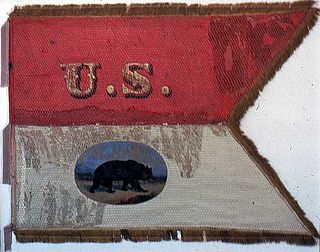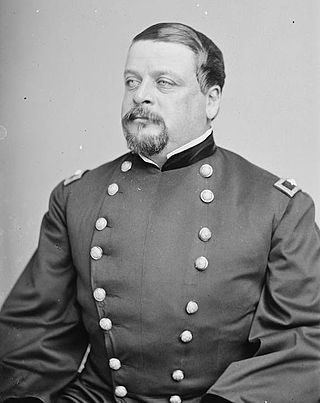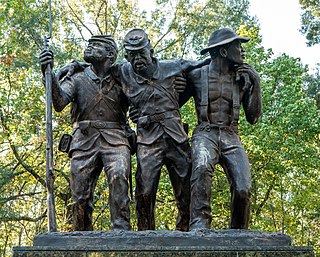
United States Colored Troops (USCT) were Union Army regiments during the American Civil War that primarily comprised African Americans, with soldiers from other ethnic groups also serving in USCT units. Established in response to a demand for more units from Union Army commanders, USCT regiments, which numbered 175 in total by the end of the war in 1865, constituted about one-tenth of the manpower of the army, according to historian Kelly Mezurek, author of For Their Own Cause: The 27th United States Colored Troops. "They served in infantry, artillery, and cavalry." Approximately 20 percent of USCT soldiers were killed in action or died of disease and other causes, a rate about 35 percent higher than that of white Union troops. Numerous USCT soldiers fought with distinction, with 16 receiving the Medal of Honor. The USCT regiments were precursors to the Buffalo Soldier units which fought in the American Indian Wars.

The 2nd Massachusetts Volunteer Cavalry Regiment was a regiment of cavalry troops in the Union army during the American Civil War. It consisted primarily of men from the states of California and Massachusetts, and served in the Eastern Theater, despite its western roots.

The 28th United States Colored Infantry, also called the 28th Indiana Infantry (Colored),1 was an African American infantry regiment from the state of Indiana that fought in the American Civil War.
The 1st Regiment Alabama Siege Artillery (African Descent) was an artillery regiment recruited from African-Americans that served in the Union Army during the American Civil War. The regiment was renamed the 6th US Colored Heavy Artillery. Under the leadership of Major Lionel Booth, the regiment fought at the Battle of Fort Pillow on April 12, 1864. The regiment then became the 7th US Colored Heavy Artillery, and later the 11th United States Colored Infantry.

The 4th United States Colored Infantry Regiment was an African-American unit of the Union Army during the American Civil War. A part of the United States Colored Troops, the regiment saw action in Virginia and North Carolina, taking part in the Richmond-Petersburg Campaign, the capture of Fort Fisher and Wilmington, North Carolina, and the Carolinas Campaign.
The 6th United States Colored Infantry Regiment was an African American unit of the Union Army during the American Civil War. A part of the United States Colored Troops, the regiment saw action in Virginia as part of the Richmond–Petersburg Campaign and in North Carolina, where it participated in the attacks on Fort Fisher and Wilmington and the Carolinas Campaign.

Alfred Gibbs was a career officer in the United States Army who served as an officer during the Mexican-American War and Apache Wars. He served as a brigadier general in the Union Army during the American Civil War.

Louis Henry Carpenter was a United States Army brigadier general and a recipient of the Medal of Honor for his actions in the American Indian Wars.
The 67th Ohio Infantry Regiment was an infantry regiment in the Union Army during the American Civil War.
The 11th United States Colored Infantry was an infantry regiment that served in the Union Army during the American Civil War. The regiment was composed of African American enlisted men commanded by white officers and was authorized by the Bureau of Colored Troops which was created by the United States War Department on May 22, 1863.

The 51st United States Colored Infantry Regiment was an infantry regiment composed of African-American troops recruited from Mississippi that served in the Union Army during the American Civil War. Initially formed in the spring of 1863 as the 1st Regiment Mississippi Volunteer Infantry (African Descent), the Regiment took part in fierce fighting at the Battle of Milliken's Bend, served on garrison duty in Louisiana, and then took part in the Battle of Fort Blakely, the last major battle of the war.
The 41st United States Colored Infantry was an infantry regiment that served in the Union Army during the American Civil War. The regiment was composed almost entirely of African American enlisted men and commanded by white officers. The regiment was authorized by the Bureau of Colored Troops which was created by the United States War Department on May 22, 1863. The regiment engaged in the Siege of Petersburg and Appomattox Campaign and was present at the unconditional surrender of Confederate General Robert E. Lee and the Army of Northern Virginia at Appomattox Court House on April 9, 1865.
The 19th United States Colored Infantry was an infantry regiment that served in the Union Army during the American Civil War. The regiment was composed of African American enlisted men, mostly from southern Maryland and that state's Eastern Shore. Commanded by white officers, it was authorized by the Bureau of Colored Troops which was created by the United States War Department on May 22, 1863.
The 52nd United States Colored Infantry was an infantry regiment composed of African-American troops recruited from Mississippi that served in the Union Army during the American Civil War. On July 4, 1864, the 52nd Colored Infantry fought a battle at Coleman's Plantation in Jefferson County, Mississippi. This engagement is notable as it is most likely the first time that Black soldiers from Mississippi fought against white Confederates from the same state.
The 53rd United States Colored Infantry was an infantry regiment that served in the Union Army during the American Civil War. Originally formed as the 3rd Regiment Mississippi Volunteers (African Descent), the regiment was composed of African American enlisted men commanded by white officers. The 53rd served on garrison duty in Louisiana, Mississippi, and Arkansas before being mustered out of service in 1866.
The 58th United States Colored Infantry was an infantry regiment that served in the Union Army during the American Civil War. Originally organized as the 6th Mississippi Infantry (African Descent) on August 27, 1863, the regiment was redesignated as the 58th USCT Infantry on March 11, 1864. The regiment was composed of African American enlisted men from Mississippi commanded by white officers.

The 2nd Mississippi Infantry Regiment was a unit of the Confederate States Army during the American Civil War. The 2nd Regiment was composed of volunteer companies from North Mississippi which were sent to join the Confederate forces in Virginia in the spring of 1861. As part of the Army of Northern Virginia, the 2nd Regiment fought in many of the most decisive battles of the Eastern theater of the American Civil War, suffering heavy casualties at Antietam and Gettysburg.
The 66th United States Colored Infantry Regiment was an infantry regiment composed of African-American troops recruited from Mississippi that served in the Union Army during the American Civil War. The 66th Regiment was posted on garrison duty in Mississippi, Louisiana, and Arkansas, and fought several skirmishes with Confederate troops around the Mississippi River before being mustered out of service in 1866.
The 2nd Mississippi Cavalry Regiment was a unit of the Confederate States Army from Mississippi. Formed in the spring of 1862, the 2nd Cavalry took part in many battles of the western theater in Mississippi, Alabama, Georgia, and Tennessee before surrendering in April 1865.
The 4th Louisiana Native Guard Infantry Regiment was an African-American unit of the Union Army during the American Civil War. The 4th Native Guard was later redesignated as the 4th Regiment, Corps d' Afrique, and then finally as the 76th US Colored Infantry Regiment. The Regiment took part in battles at Port Hudson, Louisiana, and Fort Blakely, Alabama before being mustered out of service in December, 1865.








